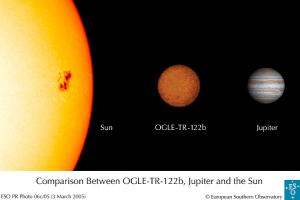Can a star look like a planet? Evidently so, to judge from observations of the star OGLE-TR-122. Astronomers working at the European Southern Observatory’s Paranal Observatory in Chile have discovered that the star experiences a drop in brightness every 7 days 6 hours and 27 minutes, a strong indication (when combined with radial velocity measurements) that a low-mass star is regularly moving in front of its larger companion as seen from Earth. Measuring radial velocity allows scientists to discriminate between stars and planets as the cause of the brightness variations.
The OGLE (Optical Gravitational Lensing Experiment) survey has been studying changes in the brightness of stars that could be caused by the transit of such unseen companions. And this one, christened OGLE-TR-122b, turns out to be a rarity indeed. It adds up to one-eleventh of the Sun’s mass, making it the smallest known star, only 16 percent larger than Jupiter though 96 times as massive as that planet.
 “This result shows the existence of stars that look strikingly like planets, even from close by,” emphasizes Frederic Pont of the Geneva Observatory (Switzerland). “Isn’t it strange to imagine that even if we were to receive images from a future space probe approaching such an object at close range, it wouldn’t be easy to discern whether it is a star or a planet?” You can read more in this European Southern Observatory press release.
“This result shows the existence of stars that look strikingly like planets, even from close by,” emphasizes Frederic Pont of the Geneva Observatory (Switzerland). “Isn’t it strange to imagine that even if we were to receive images from a future space probe approaching such an object at close range, it wouldn’t be easy to discern whether it is a star or a planet?” You can read more in this European Southern Observatory press release.
Image: ESO PR Photo 06c/05 is a comparison between the newly found low-mass star OGLE-TR-122b and the Sun and Jupiter. OGLE-TR-122b, while still 96 times as massive as Jupiter, is only 16% larger than this giant planet. It weighs 1/11th the mass of the Sun and has 1/8th of its diameter. (Credits: Sun image: SOHO/ESA; Jupiter: Cassini/NASA/JPL/University of Arizona/ESA)
Also provocative is this: many of the so-called ‘hot Jupiters’ that have been found orbiting close to their primaries may well have radii that are larger than OGLE-TR-122b. The radius of exoplanet HD209458b, which orbits a Sun-like star about 150 light years from Earth in the constellation Pegasus, is about thirty percent larger than that of Jupiter, thus making at least one planet larger than a known star.
Centauri Dreams note: If HD209458b sounds familiar, it is because this is the planet, provisionally nicknamed Osiris, whose transits across the face of its star provided the first measurements of oxygen and carbon in the atmosphere of an exoplanet. As for our work with other exoplanets, the discovery of OGLE-TR-122b reminds us once again not to draw too many preliminary conclusions from photometric data. If a tiny star can display the same transit ‘signature’ as a planet, then a presumed new planetary system may in fact be an eclipsing binary.
And here’s the kicker: many of the transit candidates studied by OGLE have turned out to be exactly that — eclipsing binaries. The OGLE team has found 177 planetary transit candidates in its survey of several hundred thousand stars. The subsequent radial velocity measurements show that eclipsing binaries are often the culprit. A survey of 60 transit candidates from OGLE data has resulted in five transiting exoplanets; the rest of the field are actually small stars.
So we’re learning that the boundaries between star and planet may be trickier to define than we thought. And our knowledge of low-mass stars is about to increase dramatically; OGLE has found seven new eclipsing binaries with masses below one-third that of the Sun.


AAVSO Alert Notice 398
Eclipse of epsilon Aurigae
July 10, 2009
The bright, long-period, eclipsing binary star epsilon Aurigae is
predicted to begin its next eclipse late July or early August of 2009.
The AAVSO is participating in a global campaign to record this eclipse
as part of the International Year of Astronomy 2009 celebrations,
organized by the Citizen Sky project (http://www.citizensky.org).
Epsilon Aurigae is now past solar conjunction and has reappeared as a
morning object. All observers — both visual and instrumental — are
encouraged to contribute observations of the eclipse during the next two
years, beginning immediately for morning observers. Observations are
urgently requested right now because it is less likely to be observed in
the morning, and the eclipse will begin within the next month.
Epsilon Aurigae is a bright (V ~ 3.0 out of eclipse), northern eclipsing
variable with a known period of 27.12 years. Eclipses have a duration
of several hundred days. It is not currently clear what the eclipsing
object is, although the leading theory is that it is a massive, opaque
dust disk surrounding either a single massive secondary star, or a pair
of stars in a tight orbit. Observations obtained during this eclipse
will help us to refine the properties of this enigmatic system.
Visual observers are particularly encouraged to observe epsilon Aurigae.
For experienced observers, please observe this star on a weekly basis,
using charts available via VSP from the AAVSO website. For novice
observers, we recommend participating in this observing program by
following the Citizen Sky 10-Star tutorial program, which provides a
simple training experience in variable star observing. The 10-star
tutorial is available at the following website:
http://www.citizensky.org/content/10-star-training
The rest of this notice and more information on epsilon Aurigae is here:
http://www.aavso.org/publications/alerts/alert398.shtml